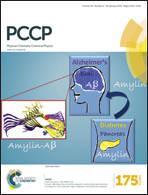Hydrogen-bonding and vibrational coupling of water in a hydrophobic hydration shell as observed by Raman-MCR and isotopic dilution spectroscopy†
Abstract
Hydrogen-bonding and intra/intermolecular vibrational coupling of water next to a hydrophobic molecule (tert-butyl alcohol, TBA) have been studied by Raman multivariate curve resolution (Raman-MCR) and isotopic dilution spectroscopy. Raman-MCR provides the vibrational spectrum of water pertinent to the hydration shell of TBA, which shows a distinct Raman band at around 3660 cm−1 corresponding to the dangling OH in the hydration shell. The presence of positive charge on the hydrophobe decreases the propensity of dangling OH in the hydration shell, presumably due to unfavorable electrostatic interaction. Analysis of the dangling OH band with isotopic dilution reveals that the ‘dangling OH’ is intramolecularly coupled with the ‘H-bonded OH’ of the same water molecule. The hydration water spectrum in the H-bonded OH stretch region (3000–3600 cm−1) shows a depletion of weakly H-bonded water (∼3580 cm−1) and an increase of strongly H-bonded water (∼3250 cm−1), making the average H-bonding stronger in a hydrophobic hydration shell than that in bulk. This strongly H-bonded hydration water exhibits weaker intra- and intermolecular vibrational coupling than that of bulk water.


 Please wait while we load your content...
Please wait while we load your content...